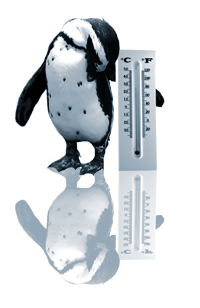Climántica :: Biblioteca
- Galego
- |
- Castellano
- |
- English
The planet’s history
Our planet’s history started 4500 million years ago when several stellar bodies were joining themselves until the Earth achieved the present size. As a young planet, the Earth’s surface and internal features were changing due to the meteorites’ impacts and later on, to the movement of tectonic plates which caused the opening and closing of oceans, the rising of mountain ranges and so on.
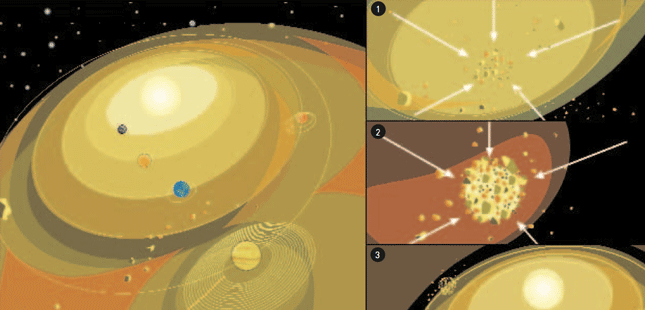
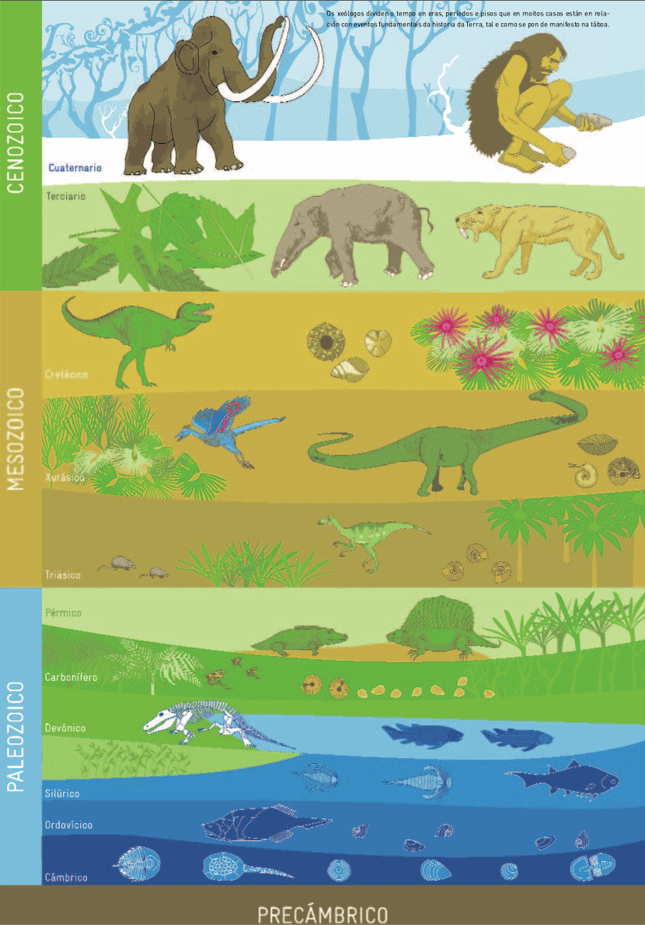
The Earth’s calendar
We are used to measuring time in days, months, and years and to studying events which date back to several centuries in the humankind’s history. But it still becomes very hard for us to change our perception of time and to locate events dated in million years.

A key moment on the planet’s history is the appearance of the first forms of life we have proof of, thanks to the discovery of 3 500-years-old fossils.

Therefore, it seems reasonable to think that until the present the Earth underwent several shifts in climate that had to, as it actually happens, leave traces in natural elements, such as rocks, fossils, plants, etc. The science that studies the past climates is called Paleoclimatology.
The study of past climates
Scientists have to work like detectives, looking for clues that help them understand the shifts in climate that took place in distant times. The instruments they use are different from those used to study today’s climate: you should remember that we only have at our disposal those data gathered by meteorological instruments designed by man since 1860.

 The study of past climates requires the use of different instruments adapted to the needs of the time scale to which they are going to date back: these instruments are called the paleoclimatic markers.
The study of past climates requires the use of different instruments adapted to the needs of the time scale to which they are going to date back: these instruments are called the paleoclimatic markers.
One of the first paleoclimatic indicators we have in mind are the historical records used for climatic reconstructions at thousand-year-scales. They are mainly based on ancient writings and inscriptions related to periods of droughts, floods, remarkable frosts. There are engravings from the 17th century that show the London’s river Thames completely frozen.
These situations were used to organise markets on the frozen river.
In their process of piling up on the polar caps and glaciers, snow and ice retain valuable information on the planet’s climate conditions over the last million years. Then it is necessary to apply methods on the ice samples that kept in that information which will act as a sort of “clocks” in order to determine the age of the ice block and to know when those components were retaine
what do tree rings tell us?
The first step consists of dating this ice traces by means radioactive isotopes such as 14C. This is the best-known radio chronological method and it is based on the idea that in living beings the proportion between standard carbon (12C) and radioactive carbon (14C) keeps constant in their composition because plants trap it from the atmosphere.
This proportion is due to the fact that the radioactive form is produced on the higher layers of the atmosphere by means of the cosmic rays’ impact on the stable nitrogen (14N), which transforms it into radioactive carbon (12C) per each radioactive carbon (14C):

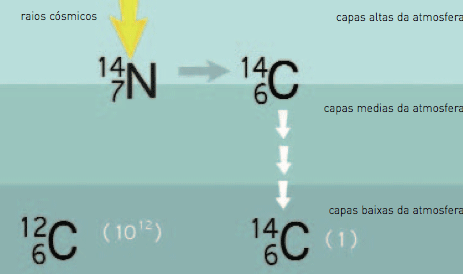
When animals or plants die they stop introducing the atmosphere’s carbon by means of nutrition. Therefore, the radioactive carbon is decomposed into standard or stable carbon, reducing this proportion. In this way, the proportion is diminishing gradually over the time, since the numerator (14C) diminishes and the denominator (12C) increases. 5 730 years (average life) have to pass so that this proportion is reduced to a half. If the 14C/12C proportion of a fossil is known, its estimated age can be known by using the data of average life. In order to be able to date with this method, the “average life” or time in which half of certain quantity of radioactive isotope decomposes must be known. Therefore, this sort of methods consists of studying the proportion between the radioactive initial isotope and the resulting isotope.
Ice cores
With theses radioactive methods the age of different ice traces sampled at different levels can be determined. Once the age of the ice trace is determined, the scientists who want to know the relevant moments regarding the climate change study the relationship between the oxygen isotopes of the sample, since it is a gas that allows reconstructing the shifts in climate taking into account the relationship between its isotopes. The oxygen has two stable isotopes: the 16O and the 18º. The latter, which is the heaviest, will mount more resistance to evaporation on the ocean’s surface.

Taking into account that during the warm (interglacial) periods the process of water evaporation makes oceans poor in 18O, increasing after this condensation in the glaciers ice. In contrast, during the old periods (ice ages), water evaporation containing 18O was lower, producing an opposite effect: ice became poorer in that isotope. In addition, ice contains dust particles as a result of volcanic eruptions than influenced on the atmosphere’s composition.
what do tree rings tell us?s
Another paleoclimatic marker is the tree rings, where data from 10 000 years ago can be obtained. At the same time, comparing the fossil trunk rings of the same tree species (for example, the sequoia) dated by using radioactive methods at different times, a comparative idea between the characteristic times of the fossils can be obtained.
This science called “Dendrochronology” studies the relationship between climate and the tree’s growth that can be affected by the degree of insolation, the rainfall or the temperatures to which is subject in the different growing stages.
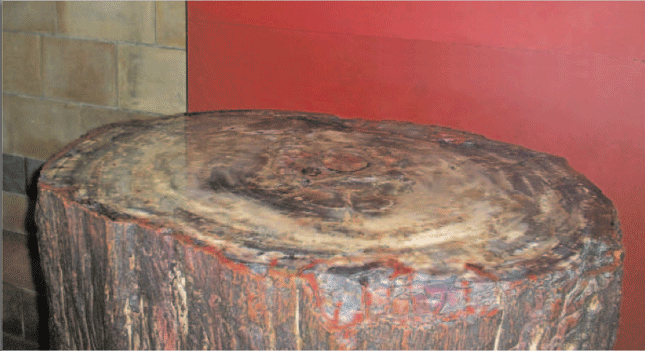
 According to the dating with radioactive methods like 14C , fossil trunks from the same species located in the same region and which lived in different times allow compare the climate of those regions at those trees’ times. The reason is that tree rings register the growth for a year because the ring is made of the wood vessels produced during the spring and summer growth.
According to the dating with radioactive methods like 14C , fossil trunks from the same species located in the same region and which lived in different times allow compare the climate of those regions at those trees’ times. The reason is that tree rings register the growth for a year because the ring is made of the wood vessels produced during the spring and summer growth.
The sediments of ocean depths
Other remarkable evidence of climate change is given by the sediments left on the ocean depths, made of organic remains and inorganic matter that can provide with data on temperature, water salinity, volume of nutrient in the first case, and the humidity or dryness conditions in the case of land material. A lot of organisms are used to living under specific climate conditions: for example, if the relative proportion of cold water species as compared to those of warm water is studied on a sample of sea depth sediment, an idea of that region’s climate can be obtained..


If you want to go further in the research on past climates and date back to million years in the planet’s history, it is necessary to study the sedimentary rocks. The type of rock is mainly conditioned by climate in the moment when sediments were settling, which later on, after litification, gave place to it. Some examples of these rocks are the following: evaporites, formed in warm and dry climates; carbon, linked to warm and hot climates; and calcarian reefs found in warm and shallow seas.
Very hot origins
Now we have the necessary instruments, we only have to implement them in order to get a global vision of the climate changes taken place on the planet. On the other hand, the geological knowledge explains that the Earth’s climate evolution is complex and that is directly linked to several aspects regarding the atmosphere-ocean-Earth interactions and the position occupied in the Solar System.
Conclusions on climate’s evolution can also be withdrawn regarding the atmosphere and the existence of life. Scientists accept that there was a primitive atmosphere that disappeared giving way to a secondary atmosphere composed mainly of water vapour and CO2

The appearance of living beings on Earth
The planet managed to retain the atmosphere due to gravity, letting the lightest gases such as the hydrogen out, and keeping the heaviest compounds. At this stage, the land surface’s temperature would be still high due to the greenhouse effect caused by CO2 and water vapour.

The atmosphere’s conditions have remarkably changed when the first form of life appeared on the Earth. The first living beings, the cyanbacteria, are CO2 consumers which trap it in sedimentary structures called stromatolites, releasing O2 into the atmosphere.
In the course of the Earth’s history the carbon dioxide variations can be correlated to the living beings’ activity. The succeeding ice ages about 1 000-570 million years ago coincide with an enormous biological diversity that largely helped eliminating the CO2 from the atmosphere with a subsequent decrease of temperatures.
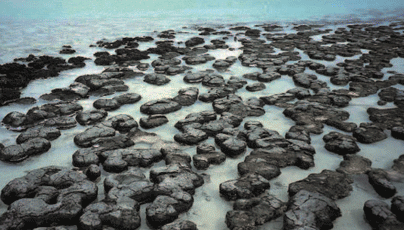 Stromatolites are sedimentary formations produced by the action of micro organisms such as cyanbacteria. The oldest date back to the Precambrian period, that occurred 3.500 million years ago. These micro organisms were the first to recycle the CO2, releasing oxygen into the atmosphere. Nowadays stromalites grow in warm waters coasts, such as the Australian Shark Bay.
Stromatolites are sedimentary formations produced by the action of micro organisms such as cyanbacteria. The oldest date back to the Precambrian period, that occurred 3.500 million years ago. These micro organisms were the first to recycle the CO2, releasing oxygen into the atmosphere. Nowadays stromalites grow in warm waters coasts, such as the Australian Shark Bay.
The Dinosaurs Age was warm
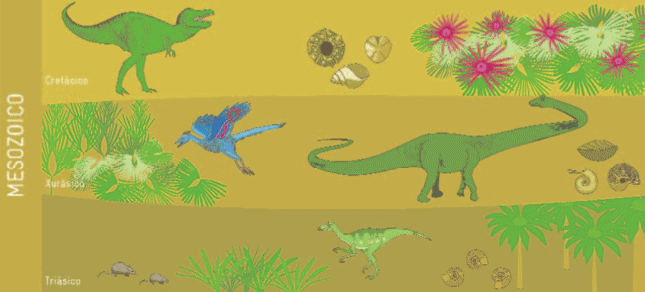
Along the Mesozoic –informally called “the Dinosaurs Age”- the Earth went through a period of warm climate used by animals and plants to spread themselves and get to high latitudes such as the “bread tree”, typical of the Tropics, whose fossil remains were found in Greenland. The data provided by the Cretaceous sedimentary records show a concentration of CO2 by about twice to twelve times higher than today’s levels.

Mammals spread across the Earth as the climate cooled down
The Earth conquered by mammals, after the extinction of most dinosaur groups –remember that birds -survived to the last Cretaceous extinction- started to become colder then. It was 38-36 million years ago when the first glaciers appeared in the South Pole and then caused a reduction of global temperatures through a “domino effect”, since the whiteness of snow reflects much more solar radiation. As a result ice reached the North Hemisphere covering half of North America and Europe over the last million years.
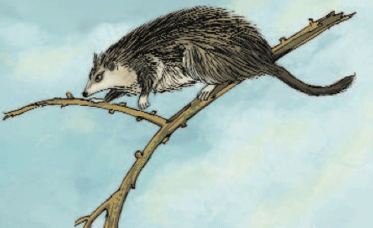
A natural database: The Antarctica
The answer to many questions and the contrast to some climatologic hypotheses is in a book made of frozen pages and the information is codified in isotopes. We are talking about the ice drillings dealt with in this chapter.
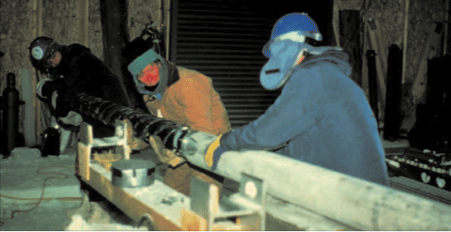
In the Antarctica’s deepest drilling, about 3 km ice were drilled out, collecting the climate’s history for the last 740 000 years. On one hand, the quantity of CO2 is determined in the air bubbles trapped and, on the other, the proportion of O2 isotopes provides us with the data on temperatures. The detailed study on these records backs up the scientific theories about the influence of CO2 on the climate system.

The interglacial period we are in occured 18 000 years ago, when the climate oscillations were constant. During the last millennium there have been data on a warm age, known as the Medieval Warm Age (between 900-1850) and a colder period, called Little Ice Age (between 1550-1850), when the surface’s temperatures were about 0.6 - 1 degrees Celsius lower than the present ones.
In the 20th century human activities trigger the global warming due to the burning of fossil fuels.
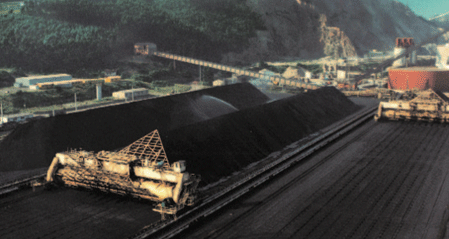
Perhaps we might think about what the past traces are telling us and become aware that harmful activities for the environment cannot be very friendly to the other part of the planet.

